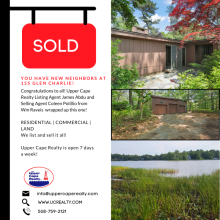Untangling Westfield...unabridged
Selectmen have long argued that the town should lease 18.5 acres of land off Charlotte Furnace Road known as the Westfield Site (part of the larger 72.52-acre Westfield Property) to a developer for the construction of senior housing. Opponents of the project have equally long argued that restrictions on the use of the property prohibit such development.
Without touching on all the pros and cons of the Westfield proposal - which voters will be asked to consider in the form of a non-binding referendum in the April 6 Town Election - this is an attempt to get to the bottom of the restriction-or-no-restriction debate.
The simple explanation is that it's not simple. The legal situation is muddy in several areas. But the following can be said with certainty:
1. There are documents on file at the Registry of Deeds that restrict use of the land. There are also documents on file that do not restrict the use of land. While not necessarily making the land undevelopable, this conflict could make it difficult for a developer to obtain a clear title for a long-term lease of the land.
2. These restrictions could probably be lifted by a vote of Wareham Town Meeting.
3. It is unclear, legally, whether leasing the property to a developer and/or lifting those restrictions would require a simple majority vote or a two-thirds majority vote at Town Meeting.
The town received a deed for the property from Campanelli Inc. on May 12, 1977. The deed, recorded in Book 4314, page 189 in the Plymouth County Registry of Deeds, contains no specific restrictions for the site's use. However, there is a general reference to rights, easements, restrictions of records, and the description of property references a subdivision plan, recorded as "Subdivision of Land to be Known as Westfield 3, Wareham, Mass. Owned by Campanelli, Inc." dated Nov. 8, 1971, and recorded with Plymouth Registry of Deeds as Plan 283 of 1972, Plan Book 16, Page 548, which did designate certain parcels (described in parcel two and parcel four - note that you may have to allow pop-ups for your browser, and then click on the "images" tab for pages 2 and 3 of the subdivision plan) to be set aside from development. It is unclear whether the subdivision was ever rescinded or cancelled and thus whether these restrictions apply.
At a Special Town Meeting on June 30, 1977, voters unanimously passed Article 10, to "authorize and direct the Board of Selectmen to acquire by gift, by purchase, by eminent domain, or otherwise, for municipal purposes certain parcels of land..." There were no other qualifications or restrictions on use mentioned in the article that was passed.
On August 9, 1977, the Selectmen signed an Order of Taking, recorded in Book 4314, page 191- 193 at the Registry, and added language that states that the Selectmen "do hereby take in fee simple for school or municipal buildings, and/or recreational, playground, and park purposes, a certain parcel of land..."
Three weeks later on August 30, 1977, the Selectmen signed another Order of Taking, recorded in Book 4323, page 111 - 113, which contained the same language as the first, and referred to the entire property as described in the deed from Campanelli Inc. to the Town.
In Massachusetts, it is customary for a buyer or a donee of property to have the title examined at the Registry of Deeds. The purpose of such examination is to reveal a proper description of the property and any rights, easements or restrictions on the property.
Such an examination would reveal two conflicting documents: the deed which has only a general reference to rights, easements, etc. and the two Orders of Taking which have the restrictions. In the course of a title review, a title examiner would customarily review the Article that was passed at Town Meeting, authorizing the taking by the town, and this would point out a third document with language different from the deed and different from the Orders of Taking.
Perhaps due to these conflicts, the law firm of Kopelman and Paige, Town of Wareham counsel, reviewed the title and gave the following opinions: There was never any acceptance by the town of the deed. In light of this, or perhaps because of this, the Article was put in at the Special Town Meeting and voted on and, subsequently, the Orders of Taking were recorded, thus becoming part of the recorded title of the property. As Kopelman and Page opinion further explains, because the article that passed was for general purposes, the site can be used for leasing to an affordable housing site. But they do put in the caveat that any potential developer or buyer may require an additional 2/3 vote by the town "While it is my opinion that the Westfield property was acquired for general municipal purposes and is presently held by the Board of Selectmen for any municipal purpose, I previously recommended that such a two-thirds "transfer" vote be sought under G.L. c.40 15A, (which applies to land held for a specific purpose) to transfer the land from the Board of Selectmen for the purpose for which it is currently held, to the Board of Selectmen for the purpose of leasing. This recommendation was made so that no argument could be made later that such a vote should have been obtained. However, it is possible that the developer may seek a two-thirds vote to have the extra insurance and avoid the possibility of challenge."
So, are there restrictions on the property? Yes, a title search would find restrictions on the property. Do these restrictions apply? Town counsel argued that they did not. They added a caveat, however, that because the restrictions are recorded in , a two-thirds vote at Town Meeting that authorizes the Selectmen to lease the property, and thereby remove the restrictions, be obtained. Kopelman and Paige suggests that this might be attractive to a developer, who would not want the development contested.
This debate ignores, of course, the argued intent for the property.
According to a letter from Dan O'Connell, a Selectman at the time, "the intent of the Board of Selectmen, me as an individual Selectman, and the members of the Town [M]eeting of 1977 was for the property known as Westfield to be used for recreational purposes only, with the caveat of a school if needed. Never, in any discussion, was housing of any kind ever discussed or authorized."
According to the 1977 Town Report available in the Town Clerk's office, the town took multiple parcels of land for specific non-recreational purposes: At the Special Town Meeting held on April 19, 1977, and at Annual Town Meeting, the town took land for drainage easements under Articles 6, 8, and 11-29, and 29 and 30, respectively. At a Special Town Meeting on June 30, 1977, they specified land for a municipal industrial park on article 5.
Why did they not specify the intent for the Westfield property in the Town Meeting Warrant?
O'Connell said that Town Meeting voters, during discussion, stipulated that the property be used for recreational use. The Board of Selectmen would ensure this stipulation through the Orders of Taking, which the Town Meeting vote, he said, authorized them to do.
In fact, O'Connell said that he considered the Orders of Taking to be not restrictive enough. On his honeymoon at the time, he did not sign the documents and regrets not being able to change the language in the Orders to restrict the property for only recreational purposes with a caveat that a school be built if necessary. John Decas, a member of the School Board at the time, agreed that the only building proposed for the property was a future high school. But he said that the site was not one of their top choices so they weren't too concerned about further restricting the property...plus after several previous sites had been rejected, he said that they wanted to have the possibility that a school could be built on the site.
"That was where the screw-up occurred," O'Connell said.
So how do you decide whether the property has use restrictions?
One side of the legal argument, as held by Town Counsel Kopelman and Paige, is that if the town can use the property for "municipal purposes" as voted at the Special Town Meeting in 1977, then the Selectmen can lease the property to a developer with the approval of a simple majority vote at Town Meeting. On the other side of the legal argument, if the town holds the property subject to the restrictions set forth in the Orders of Taking, then a two-thirds vote at Town Meeting would be required for the Selectmen to lift the restrictions and lease to a developer.
Kopelman and Paige recommended the town obtain a two-thirds majority vote as a cautionary measure. The Westfield Article at last October's Town Meeting did not specify that a two-thirds majority was required, and there appears to have been confusion over whether a simple majority or a two-thirds vote was needed.
O'Connell attributes the confusion over the use restrictions of the property, and the confusion over how to rectify this, to...confusion.
He explained that in 1977, the economy was in recession and the Board had just transitioned from three full-time selectmen to five part-time selectmen.
Plus, he said, "we were going through town administrators like crap goes through a goose."













